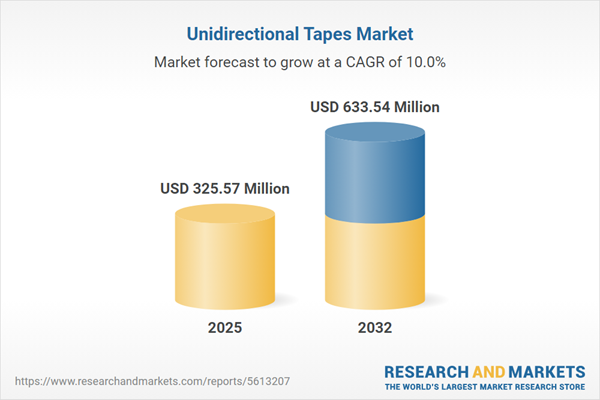Speak directly to the analyst to clarify any post sales queries you may have.
The unidirectional tapes market is advancing rapidly, driven by expanding adoption across industries seeking lightweight, durable, and high-performance materials. This report equips decision-makers with targeted analysis essential for navigating opportunities and challenges in this evolving sector.
Market Snapshot: Unidirectional Tapes Market Growth and Outlook
The global unidirectional tapes market grew from USD 296.25 million in 2024 to USD 325.57 million in 2025 and is projected to reach USD 633.54 million by 2032, with a CAGR of 9.96%. This sustained growth is powered by the accelerating shift towards advanced materials in high-demand sectors. Adoption is notably robust within industries prioritizing lightweight construction and high-strength components, reflecting investment in advanced composites and specialized reinforcing systems. Organizations pursuing process efficiency and improved sustainability are finding unidirectional tapes increasingly aligned with their material requirements.
Scope & Segmentation: Unidirectional Tapes Market
Senior executives gain a comprehensive view of evolving demand factors, supply chain influences, and strategic opportunities with an in-depth segmentation analysis. The report examines application breadth, technology innovations, and regional considerations that inform procurement and deployment strategies.
- Adhesive Types: Solutions encompass acrylic adhesives for balanced tack, rubber variants offering rapid bonding, and silicone systems for enhanced resistance to temperature and chemicals.
- End Use Sectors: Coverage includes aerospace (emphasis on structural integrity), automotive (distinct approaches for commercial and passenger segments), construction (commercial and residential fit), electronics (consumer and industrial devices), and healthcare (focus on sterilization compatibility).
- Product Types: Materials range from PET and polyimide to polypropylene, PTFE, and PVC, supporting varying needs for mechanical strength and chemical resistance.
- Backing Materials: Cloth substrates offer flexibility, film options ensure lightweight durability and thermal performance, and paper backings contribute to cost effectiveness in select applications.
- Application Domains: Principal uses include electrical insulation, masking, packaging, and critical surface protection tasks.
- Regional Coverage: In-depth assessments span North America, Latin America, Europe, the Middle East, Africa, and Asia-Pacific, addressing countries such as the United States, Germany, China, and India, while analyzing regulatory and demand variations.
- Key Suppliers: Analysis of major participants includes 3M Company, Tesa SE, Berry Global Group, Inc., Nitto Denko Corporation, Avery Dennison Corporation, Intertape Polymer Group Inc., Scapa Group plc, LINTEC Corporation, Shurtape Technologies LLC, and Lohmann GmbH & Co. KG.
Key Takeaways for Senior Decision-Makers
- Increasing use of unidirectional tapes reflects industry-wide strategies for reducing weight and boosting mechanical reliability in critical components.
- New adhesive chemistries and advanced fiber architectures are pushing system performance and enhancing operational outcomes for OEMs and suppliers.
- Environmental compliance initiatives are accelerating the adoption of eco-friendly adhesives and recyclable backing substrates.
- Integration of digital manufacturing technologies and real-time quality assurance supports stringent reliability needs in sophisticated end-user markets.
- Supply chain resilience is advancing through the adoption of diversified sourcing and risk-sharing partnership models that address market volatility.
- Regional adoption is influenced by local manufacturing capacities and specific industry focuses, requiring a tailored approach to entering high-growth markets.
Tariff Impact on the Unidirectional Tapes Market
Recent United States tariff measures have significantly influenced sourcing approaches and supplier portfolios, generating price realignments across the value chain. As domestic manufacturers benefit from local production incentives, suppliers are recalibrating procurement and inventory strategies to resist disruptions. The adoption of new partnership structures, including consignment stock programs and risk-sharing agreements, is advancing cost management and operational continuity. These market responses highlight the growing importance of flexible supply chain models in safeguarding competitiveness.
Methodology & Data Sources
This report utilizes a multi-source research methodology, drawing from technical literature, industry databases, and regulatory filings. Insights from interviews with executives, research and development specialists, and procurement professionals further strengthen the market narrative. Data triangulation methods support the precision and dependability of all findings presented.
Why This Report Matters
- Facilitates strategic decision-making with rigorous analysis of technology shifts, supply chain developments, and emerging end-user requirements in the unidirectional tapes market.
- Offers a nuanced perspective into policy changes, digital transformation, and competitive positioning, directly impacting procurement and investment decisions.
- Enables identification and assessment of evolving partnership models and supply chain frameworks, supporting agility and margin protection in volatile markets.
Conclusion
This analysis provides senior leaders with actionable insights to align investments and operational planning with progressing material technologies and shifting regulatory demands. Leveraging these findings informs long-term strategies for market resilience and sustained advantage.
Additional Product Information:
- Purchase of this report includes 1 year online access with quarterly updates.
- This report can be updated on request. Please contact our Customer Experience team using the Ask a Question widget on our website.
Table of Contents
3. Executive Summary
4. Market Overview
7. Cumulative Impact of Artificial Intelligence 2025
List of Figures
Samples

LOADING...
Companies Mentioned
The key companies profiled in this Unidirectional Tapes market report include:- 3M Company
- Tesa SE
- Berry Global Group, Inc.
- Nitto Denko Corporation
- Avery Dennison Corporation
- Intertape Polymer Group Inc.
- Scapa Group plc
- LINTEC Corporation
- Shurtape Technologies LLC
- Lohmann GmbH & Co. KG
Table Information
| Report Attribute | Details |
|---|---|
| No. of Pages | 185 |
| Published | October 2025 |
| Forecast Period | 2025 - 2032 |
| Estimated Market Value ( USD | $ 325.57 Million |
| Forecasted Market Value ( USD | $ 633.54 Million |
| Compound Annual Growth Rate | 9.9% |
| Regions Covered | Global |
| No. of Companies Mentioned | 11 |









